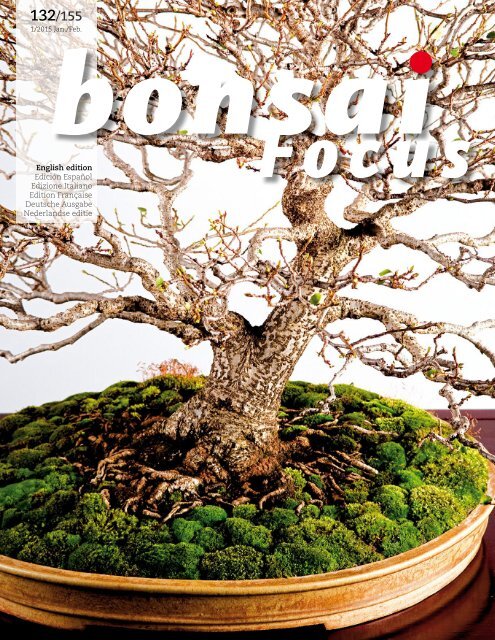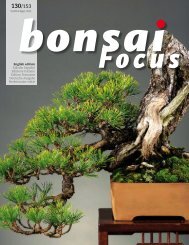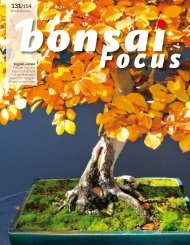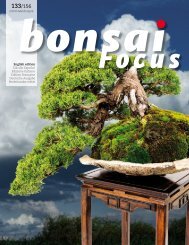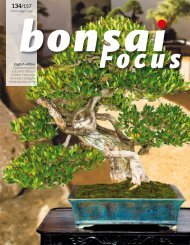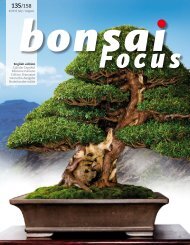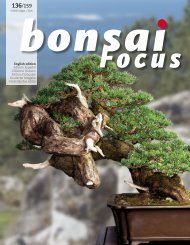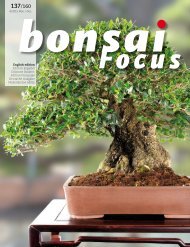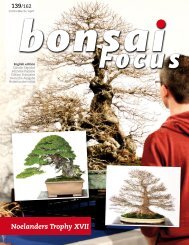BONSAI FOCUS 2015-1 EN PREVIEW
Discover how fascinating Bonsai Focus is! With informative reports and stunning photography every two months, Bonsai Focus Magazine makes you eye-witness extraordinary bonsai, magnificent stylings of famous masters, educational techniques and useful maintenance tips. Articles are often supported by exclusive and breathtaking videos.
Discover how fascinating Bonsai Focus is! With informative reports and stunning photography every two months, Bonsai Focus Magazine makes you eye-witness extraordinary bonsai, magnificent stylings of famous masters, educational techniques and useful maintenance tips. Articles are often supported by exclusive and breathtaking videos.
Create successful ePaper yourself
Turn your PDF publications into a flip-book with our unique Google optimized e-Paper software.
132/155<br />
1/<strong>2015</strong> Jan./Feb.<br />
English edition<br />
Edición Español<br />
Edizione Italiano<br />
Edition Française<br />
Deutsche Ausgabe<br />
Nederlandse editie
Bonsai Focus<br />
EDITORIAL<br />
3<br />
Who we are<br />
Publisher<br />
Bonsai Europe Publications<br />
Houtrustweg 96,<br />
2566 GJ The Hague<br />
The Netherlands<br />
Europe:<br />
Tel.: +31 (0)85 90 20 900<br />
Office hours: 9am - 5pm (CET)<br />
USA:<br />
Tel.:(+1) 703-738-9965<br />
Office hours: 9am - 5pm (East Coast)<br />
E-mail:<br />
info@bonsaifocus.com<br />
Website:<br />
www.bonsaifocus.com<br />
Chief Editor:<br />
Farrand Bloch<br />
editor@bonsaifocus.com<br />
Editorial staff:<br />
English edition: Ann Scutcher<br />
French edition: Patrick Bosc, Matthieu<br />
Mavridis<br />
German edition: Jörg Derlien<br />
Dutch edition: Hein-Dik Barentsen<br />
Italian edition: Erika Lakin<br />
Spanish edition: Ana Ricart<br />
Advertising & Marketing:<br />
René Rooswinkel<br />
sales@bonsaifocus.com<br />
Subscriptions & Administration:<br />
Marja Heijmink<br />
admin@bonsaifocus.com<br />
Issn UK: 1874 - 6853<br />
Issn US: 1876 - 6137<br />
Price:<br />
€ 11.95 | $ 14.95 | £ 9.95<br />
© Copyright <strong>2015</strong><br />
Bonsai Europe, world rights reserved. No part<br />
of this publication may be reproduced in any<br />
form without the written permission of the<br />
publisher.<br />
Bonsai Focus has a co-operation with<br />
Kinbon magazine, Kyoto, Japan<br />
Translations:<br />
Peter Warren<br />
Here I am with<br />
Taiga after his<br />
demo<br />
Squeeze it in<br />
Our whole studio was covered in<br />
dust when Taiga Urushibata worked<br />
on a huge yew. We invited him for<br />
a demonstration in our studio. The<br />
tree, a huge Japanese yew donated<br />
by Maarten van der Hoeven, hardly<br />
fitted through the door and four men<br />
were needed to lift it on to the mobile<br />
stand. Its size wasn't a problem for<br />
Taiga, used to big projects during his<br />
apprenticeship with Kimura. The yew<br />
which came from a garden did not<br />
have natural shari or jin instead it<br />
had many dead stumps facing in all<br />
directions. Taiga rapidly worked his<br />
way through the maze of stumps and<br />
stalks and soon the floor was covered<br />
with wood chips. See the results in<br />
Taiga's masterclass further on.<br />
Many, many bonsai shows this last<br />
autumn, far too many to cover in this<br />
issue so we had to make a selection.<br />
I went to the bi-annual Sakka-Ten<br />
which was held in a small town with<br />
fantastic views of the famous city of<br />
Florence. Tony Tickle was very lucky<br />
Taxus baccata, by Andrés Alvarez Iglesias<br />
Picea on rock by John Pitt<br />
Pinus parviflora on a kurama ishi, by David<br />
Benavente<br />
to be invited for the Chinese penjing<br />
event held near Shanghai. He found<br />
out that these aren't just 'penjing',<br />
but impressive well-maintained trees<br />
and absolutely not the 'old school'<br />
stuff you normally think of. Then<br />
there was the big show in Saulieu,<br />
last October, which we attended as<br />
well. A great show with amazing<br />
trees from which a few highlights are<br />
squeezed in here.<br />
An almost endless source of ideas<br />
is coming through when it comes to<br />
displaying bonsai: Philipe Leblanc<br />
and David Mailard took some of their<br />
trees to a very off beat place creating<br />
amazing images. Robert Steven did<br />
some really out of the box thinking,<br />
too, during his event in Yogyakarta,<br />
Indonesia.<br />
But as well as all the arty stuff, we<br />
have solid technical information, too;<br />
if you like comics then look and learn<br />
what to do in the article on winter<br />
maintenance.<br />
Juniperus sabina, by Xavier Massanet<br />
Farrand Bloch<br />
Chief editor
4 Bonsai Focus<br />
THIS ISSUE<br />
Our Icons<br />
Video available<br />
bonsaifocus.com<br />
Beginner<br />
Advanced<br />
On the cover<br />
Alder (Alnus) 78 cm / 31"<br />
Sakka-Ten 2010<br />
Photo: Bonsai Focus Studio<br />
Scan the code<br />
with your phone<br />
Expert<br />
22<br />
6 The Sakka-Ten in Fiesole<br />
Bonsai with the Etruscans<br />
8 Bonsai Top 30<br />
François Jeker turns Mulhouse into the capital of<br />
bonsai<br />
12 Blossoming gems<br />
The beauty of Prunus bonsai<br />
12<br />
18 The bonsai passion of...<br />
Nicola Crivelli<br />
22 Guide for short needles<br />
A how-to guide to achieving shorter pine needles<br />
28 Bonsai and street art<br />
Questioning the usual codes of bonsai display. By<br />
Philippe Leblanc and David Mailand<br />
30 Step by step<br />
An almost finished juniper can still be a challenge<br />
6
Bonsai Focus<br />
28<br />
34 Bonsai in Ink<br />
Sonia Stella loves bonsai and sumi-e drawing<br />
36 Air layer techniques<br />
How to air layer various maples and make the most of<br />
your material<br />
44 Masterclass with Taiga<br />
Taiga Urushibata shapes a raw Japanese yew<br />
50 Serious bonsai<br />
Tony Tickle travels to China for the annual penjing<br />
show<br />
56 Embrace the cypress<br />
Marco Giannini and Sandro Segneri style a massive<br />
trunked cypress<br />
62 Like a grand canyon<br />
Austin Heitzman creates special bonsai stands<br />
65 Column<br />
Tony Tickle questions how much deadwood we really<br />
need.<br />
44<br />
56<br />
66 Expert opinion<br />
François Jeker takes a look at a rosemary from Marco<br />
Rinaldi<br />
68 From pale to dark green<br />
Regaining a pine's health and improving its style, too<br />
74 Winter maintenance<br />
How to care for bonsai during winter time<br />
78 News<br />
Magic-E, a new Italian bonsai book and more . . .<br />
79 Garden visits<br />
See how readers exhibit bonsai in their gardens
6 Bonsai Focus<br />
REPORT<br />
Sakka Ten<br />
Bonsai, art and culture with the Etruscans<br />
This year's edition of Sakka-Ten<br />
was held during 7-9 November.<br />
It was organised by the Nippon<br />
Bonsai Sakka Kyookai Europe<br />
and the 'Toscana Amatori Bonsai<br />
E Suiseki' Association, and took<br />
place in the ancient Etruscan<br />
town of Fiesole which overlooks<br />
the famous city of Florence, Italy<br />
Cotinus coggygria<br />
55cm | 21'7"<br />
Photo: Bonsai Focus Studio<br />
Every two years this event is held at<br />
a special place in a special location;<br />
this time it was Fiesole up in the hills<br />
above Florence. It always takes place<br />
in autumn because, according to the<br />
organisation, it's the peak season<br />
for the colours or fruits of deciduous<br />
trees, while conifers are at their most<br />
majestic. Bonsai and suiseki exhibits<br />
are most carefully chosen to create a<br />
harmonious whole. The exhibition is<br />
set up with the utmost care. All the<br />
trees are unaccredited and need to<br />
have a certain maturity. As Edoardi<br />
Rossi, curator of the show explains:<br />
'The Sakka-Ten embodies the desire<br />
to share with others the peace that<br />
we find in cultivating our bonsai.'<br />
pyracantha<br />
60cm | 30'7"<br />
Euonymus<br />
50cm | 19'7"<br />
A bonsai market could be found at the front of<br />
the Palazzo Pretorio where the exhibition was<br />
held<br />
The European branch of the Nippon<br />
Bonsai Sakka Kyookai was founded<br />
in 2000 with the aim of spreading<br />
Juniperus sabina<br />
45cm | 17'7"<br />
interest in the ancient art of bonsai;<br />
though it is not easy to appreciate<br />
bonsai without understanding the<br />
culture from which it comes. So the<br />
association holds events and lectures<br />
on the display of bonsai.<br />
On Friday, the day before the show opened, all<br />
trees were prepared and sorted as to which tree<br />
would best fit next to the other<br />
The special guest for this year was<br />
Isao Fukita, who studied with Kunio<br />
Kobayashi at the famous Shunka-En<br />
in Tokyo. Lorenzo Agnoletti, president<br />
of the Nippon Bonsai Sakka Kyookai,<br />
The bonsai market in front<br />
of the Palazzo Pretorio
Bonsai Focus<br />
Enjoy the plum blossom in the<br />
New Year, ahead lies months of<br />
maintenance<br />
SHOHIN<br />
13<br />
Techniques by: Mr Shuji Shintani<br />
Post flowering procedure<br />
For the majority of flowers, cooler temperatures enable<br />
the tree to retain the blossoms for longer. Prunus mume is<br />
one of the first species of the year to flower and the buds<br />
are much quicker to swell and open than most, especially<br />
when brought indoors. If the trees are placed too close to<br />
a stove or air conditioning the flowers will rapidly drop off<br />
and buds start to swell. Please take note of this point.<br />
If you live in a suitable climate, once the risk of frost has<br />
passed you can place trees outside until the middle of<br />
April. Up until this point it is possible to transplant and<br />
prune.<br />
Prunus 'Hibai' Height 10 cm / 4" Pot: Toufukuji round<br />
Aim for more buds<br />
If the bud at the end of the branch, the terminal bud, is permitted to<br />
remain, it will exert an influence on the adventitious buds forcing them<br />
to stay dormant at the base of the branch. The picture shows the tip of<br />
a branch which has just lost its leaves and the terminal bud has been<br />
pruned back. This work can be repeated the following spring until the<br />
early summer when buds have started to move. The aim of the work is to<br />
create buds and then branches closer to the tree. When the flowers are<br />
brought on early, the movement of the leaf buds will also be quicker and<br />
so care must be taken.<br />
A Prunus in full leaf<br />
Advantages of speeding up growth<br />
Mrs Shintani uses speeding up the activity in the tree to<br />
her advantage. Transplanting is done early in February.<br />
After the work has been carried out, however, the trees<br />
must be protected from any potential frost damage.<br />
Pruning can take place from middle February onwards.<br />
The inviolable rule of pruning Prunus is to check carefully<br />
for presence of a leaf bud before pruning back. If done<br />
early enough, the pruning will stimulate internal buds to<br />
swell and start to grow, allowing you to prune back harder<br />
and hope for adventitious budding.<br />
This is important to consider, especially when dealing<br />
with those garden types of plant that become leggy and<br />
are difficult to compact and create ramification.<br />
Prunus 'Touji'.<br />
Height: 9 cm / 3½"<br />
Pot: Toufukuji<br />
rectangle
Bonsai Focus<br />
MAINT<strong>EN</strong>ANCE<br />
23<br />
Basic techniques of transplanting<br />
The root ball of conifers should not be entirely<br />
broken down. First start to break down the soil<br />
on the base of the root ball to approximately<br />
half the depth<br />
Then, little by little, start to work on the sides of<br />
the root ball carefully so that the roots are not<br />
damaged<br />
Finally start to work on the surface around the<br />
nebari. Check the thickness and the activity of<br />
roots before deciding whether or not to prune<br />
Roots growing in a wrong direction should be<br />
pruned. Do not cut right at the root base, but<br />
rather leave a small amount, especially if there<br />
is a small secondary root<br />
If the surface of the soil becomes compacted and<br />
water does not penetrate transplant as soon as<br />
possible. If roots are starting to float above the<br />
surface as shown here, it is a sign that there is<br />
no free room in the pot to allow growth<br />
An example of soil mixture used in the central<br />
part of Japan. On the left is large particle Kiryu<br />
which is used as a single layer in the bottom of<br />
the pot. Pumice is also okay. On the right side<br />
is Akadama, Kiryu and river grit at a ratio of<br />
7:2:1. If you want the roots to grow rapidly use<br />
a ratio of 5:3:2<br />
Candle pinching<br />
Often in the late spring, early summer, we see candles/buds that<br />
have grown far too long. Once into June, these will be entirely cut off<br />
at the base. If, though, the tree is very strong, we see elongated buds.<br />
If they are left to develop, weaker areas of the tree will continue to<br />
weaken. Pinching off the tips of the very strong buds will stop their<br />
development and redistribute energy to other buds on weaker areas<br />
of the tree. This is a great technique for energy balancing.<br />
Do this once the candle is perfectly formed, but has yet to start to<br />
open up during May. The tip is simply just snapped off using your<br />
fingertips. On weaker branches this should be avoided in favour of<br />
allowing it to grow and strengthen.<br />
There are strong, extended candles during the<br />
middle of May. Very vigorous trees will often<br />
have growth like this. It should be snapped off
30 Bonsai Focus<br />
STEP BY STEP<br />
Ready to go!<br />
A juniper that looks almost 'finished' can still be a challenge<br />
Text and photography: Bonsai Focus Studio<br />
This already quite mature juniper has lots of branches<br />
and movement in its trunk, plenty of positive points and<br />
some negative aspects that need some attention. With<br />
minimal amount of branch removal you can make an<br />
attractive bonsai with this material. Martin Bonvie takes<br />
the challenge to bring out the best in this medium sized<br />
juniper.<br />
1<br />
Analysing the tree<br />
This is a typical juniper grown for<br />
the purpose of bonsai and has an<br />
interesting trunk with shari, jin and<br />
spiral flowing live veins. It also has a<br />
good set of well developed branches<br />
with healthy shoots.<br />
Lots of<br />
healthy<br />
branches<br />
Suitable as a cascade?<br />
Maybe not . . .<br />
Live veins run in a<br />
spiral over the trunk<br />
The trunk base has an ugly<br />
narrowing here<br />
Martin is considering making a cascade as an<br />
alternative option. The flexible branches and<br />
interesting jin and shari are good ingredients<br />
for a convincing cascade; however, the trunk<br />
line has an almost 90 degree angle, which does<br />
not make it suitable for this treatment<br />
Live veins twist around<br />
the trunk; it is one of<br />
the charms of this small<br />
juniper. The narrowing<br />
at the base of the trunk<br />
is less disturbing<br />
Seen from this side the trunk base shows<br />
a better tapering at the base<br />
When tilting the tree to the left the movement<br />
of the trunk improves
Bonsai Focus<br />
SUNDRIES<br />
Special offer<br />
for Bonsai Focus subscribers !<br />
10% discount on all Sonia's paintings<br />
The offer runs untill March <strong>2015</strong><br />
Go to: www.sumi-e.fr<br />
When ordering you must enter<br />
the code: inkdiscount.<br />
35<br />
Various brushes next to a scroll painting<br />
A pine at a show with one of Sonia's scroll paintings<br />
Bark and brushes<br />
'Love Bonsai' is the title of my series<br />
devoted to trees, tall and miniature<br />
alike. I realized that without oxygen,<br />
no life would be possible. That was<br />
the trigger for my work on trees. I try<br />
to pay respect to their strength, their<br />
fragility and their ability to adapt<br />
to harsh conditions that nature can<br />
sometimes inflict on them. Bonsai<br />
needs time to get results, unlike<br />
Sumi-e that allows one to capture the<br />
image in an instant. A practitioner<br />
of bonsai must be patient, visionary<br />
to consider a work of art. He uses<br />
his technique to overcome obstacles<br />
while he respecting the tree. But a<br />
painter must catch the essence of the<br />
tree in a single gesture to project his<br />
vision on to the paper. His hand must<br />
become an extention of his heart.<br />
Sublimate nature<br />
The way of the ink is considered to<br />
be noble because it demands a long<br />
difficult apprenticeship, technically<br />
and philosophicaly. It will teach us<br />
humility, patience, dedication, and<br />
a fair vision of nature. Like a bonsai<br />
practitioner, a painter realizes his<br />
way is a lifetime commitment. In his<br />
quest for harmony and perfection,<br />
he'll always remain a student with a<br />
constant evolving potential. A painter<br />
must become familiar with natural<br />
movements of creation whatever his<br />
technical level. He learns to adjust<br />
to unexpected situations and learn<br />
from his mistakes. Even though our<br />
tools are different, it is nevertheless<br />
easy to see an analogy between<br />
bonsai and Sumi-e. It is when you<br />
realize that both disciplines try to<br />
catch the essence of nature that you<br />
can see their resemblence as obvious.<br />
To get results, painters like lovers of<br />
bonsai should abandon themselves<br />
to comtemplation and let their sensitivity<br />
come out. All arts flourish with<br />
encounters and sharing of ideas.<br />
That's how I see my work, and I<br />
couldn't practice it without sharing,<br />
because that's the only way to grow<br />
and to improve oneself. There is no<br />
alternative! I like to say: The Way of<br />
the Ink can't be explained. It just has<br />
to be experienced. It allows us to<br />
leave our footprint on the sand<br />
of time. Here and<br />
now.<br />
Sonia with her painting<br />
tools<br />
A impressive literati<br />
(above) and Sonia's<br />
steady hand working on<br />
another bonsai painting
Bonsai Focus<br />
GARD<strong>EN</strong> VISIT<br />
79<br />
Bonsai and display<br />
show us your bonsai at home<br />
We were curious to see how you display your bonsai at home. So we asked you,<br />
our readers, to show us how you enjoy your bonsai when returning back home<br />
from a long day's work. Bonsai can serve as a moment of relaxation. These images<br />
below show some of your garden displays. We would love to see more so<br />
keep them coming. Just send your photographs to editor@bonsaifocus.com<br />
Add an explanation of your rationale in about 150 words<br />
Per Frandsen<br />
Bram de Visser, Netherlands<br />
The picture from the living room to the terrace is actually my favourite place where I sit<br />
down for a quiet drink in the afternoon and enjoy my trees while looking out into the<br />
garden. Here are my most beautiful bonsai on various stands. I am especially fond of<br />
flowering native varieties, such as the apple tree which is a Bramley’s seedling, an old<br />
apple variety. I also like to place my best trees in my living room as do the Japanese.<br />
Bernd Lech, Germany<br />
I have been into bonsai since 2002. Each<br />
year I take part in the spring and autumn<br />
workshops at Ralf Beckers in Krefeld,<br />
Germany. I have only self collected trees<br />
which, thanks to Ralf Beckers, can be<br />
good bonsai. In the garden I try to create<br />
the components: bonsai, garden pond a<br />
harmonious overall picture.
Bonsai Focus<br />
NEXT ISSUE<br />
81<br />
Issue 133 March / April<br />
TECHNIQUE<br />
In Japan they're not afraid of taking dramatic measures to<br />
reach their goal. Grafting techniques are used to the max.<br />
MAINT<strong>EN</strong>ANCE<br />
Watering your bonsai is probably the hardest thing to do.<br />
We show you how to do it properly.<br />
MASTERCLASS<br />
Much world travel makes Salvatore Liporace hard to catch<br />
up with. We finally managed to track him down and got<br />
him to do another demo for us. See the result of his work<br />
on this huge pine.<br />
STYLING<br />
Valentin Brose creates a fine shohin from a yew. He shows<br />
us the correct wiring and bending techniques to get the<br />
best results.
For the complete<br />
Subscribe now!!<br />
You are just<br />
one click away!!


